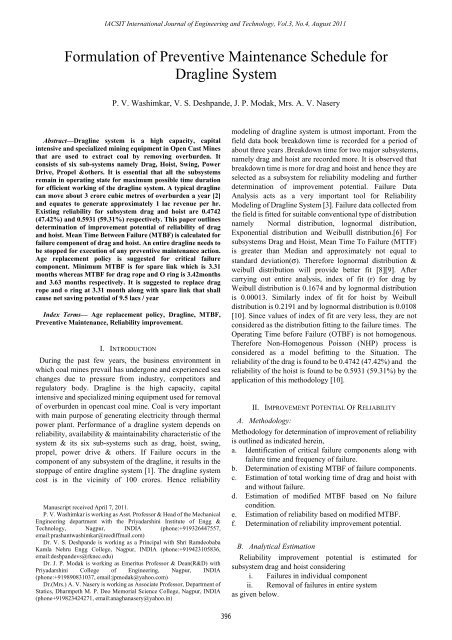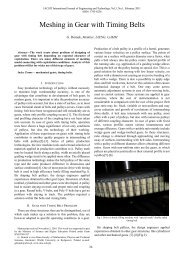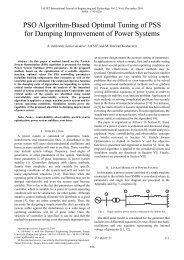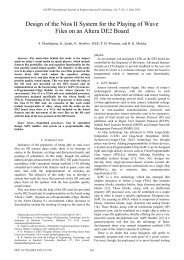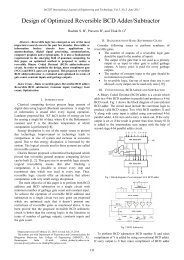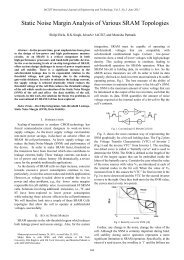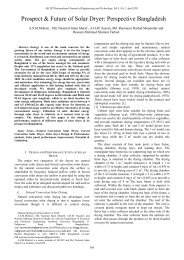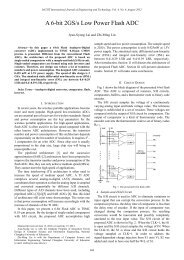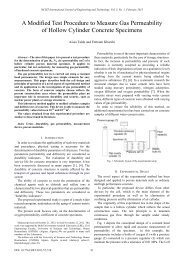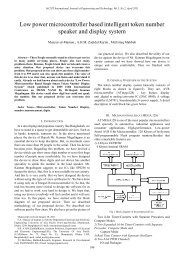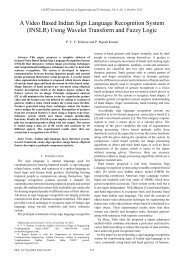Formulation of Preventive Maintenance Schedule for Dragline ... - IJET
Formulation of Preventive Maintenance Schedule for Dragline ... - IJET
Formulation of Preventive Maintenance Schedule for Dragline ... - IJET
You also want an ePaper? Increase the reach of your titles
YUMPU automatically turns print PDFs into web optimized ePapers that Google loves.
IACSIT International Journal <strong>of</strong> Engineering and Technology, Vol.3, No.4, August 2011<strong>Formulation</strong> <strong>of</strong> <strong>Preventive</strong> <strong>Maintenance</strong> <strong>Schedule</strong> <strong>for</strong><strong>Dragline</strong> SystemP. V. Washimkar, V. S. Deshpande, J. P. Modak, Mrs. A. V. NaseryAbstract—<strong>Dragline</strong> system is a high capacity, capitalintensive and specialized mining equipment in Open Cast Minesthat are used to extract coal by removing overburden. Itconsists <strong>of</strong> six sub-systems namely Drag, Hoist, Swing, PowerDrive, Propel &others. It is essential that all the subsystemsremain in operating state <strong>for</strong> maximum possible time duration<strong>for</strong> efficient working <strong>of</strong> the dragline system. A typical draglinecan move about 3 crore cubic metres <strong>of</strong> overburden a year [2]and equates to generate approximately 1 lac revenue per hr.Existing reliability <strong>for</strong> subsystem drag and hoist are 0.4742(47.42%) and 0.5931 (59.31%) respectively. This paper outlinesdetermination <strong>of</strong> improvement potential <strong>of</strong> reliability <strong>of</strong> dragand hoist. Mean Time Between Failure (MTBF) is calculated <strong>for</strong>failure component <strong>of</strong> drag and hoist. An entire dragline needs tobe stopped <strong>for</strong> execution <strong>of</strong> any preventive maintenance action.Age replacement policy is suggested <strong>for</strong> critical failurecomponent. Minimum MTBF is <strong>for</strong> spare link which is 3.31months whereas MTBF <strong>for</strong> drag rope and O ring is 3.42monthsand 3.63 months respectively. It is suggested to replace dragrope and o ring at 3.31 month along with spare link that shallcause net saving potential <strong>of</strong> 9.5 lacs / yearIndex Terms— Age replacement policy, <strong>Dragline</strong>, MTBF,<strong>Preventive</strong> <strong>Maintenance</strong>, Reliability improvement.I. INTRODUCTIONDuring the past few years, the business environment inwhich coal mines prevail has undergone and experienced seachanges due to pressure from industry, competitors andregulatory body. <strong>Dragline</strong> is the high capacity, capitalintensive and specialized mining equipment used <strong>for</strong> removal<strong>of</strong> overburden in opencast coal mine. Coal is very importantwith main purpose <strong>of</strong> generating electricity through thermalpower plant. Per<strong>for</strong>mance <strong>of</strong> a dragline system depends onreliability, availability & maintainability characteristic <strong>of</strong> thesystem & its six sub-systems such as drag, hoist, swing,propel, power drive & others. If Failure occurs in thecomponent <strong>of</strong> any subsystem <strong>of</strong> the dragline, it results in thestoppage <strong>of</strong> entire dragline system [1]. The dragline systemcost is in the vicinity <strong>of</strong> 100 crores. Hence reliabilityManuscript received April 7, 2011.P. V. Washimkar is working as Asst. Pr<strong>of</strong>essor & Head <strong>of</strong> the MechanicalEngineering department with the Priyadarshini Institute <strong>of</strong> Engg &Technology, Nagpur, INDIA (phone:+919326447557,email:prashantwashimkar@reediffmail.com)Dr. V. S. Deshpande is working as a Principal with Shri RamdeobabaKamla Nehru Engg College, Nagpur, INDIA (phone:+919423105836,email:deshpandevs@rknec.edu)Dr. J. P. Modak is working as Emeritus Pr<strong>of</strong>essor & Dean(R&D) withPriyadarshini College <strong>of</strong> Engineering, Nagpur, INDIA(phone:+919890831037, email:jpmodak@yahoo.com)Dr.(Mrs.) A. V. Nasery is working as Associate Pr<strong>of</strong>essor, Department <strong>of</strong>Statics, Dharmpeth M. P. Deo Memorial Science College, Nagpur, INDIA(phone+919823424271, email:anaghanasery@yahoo.in)modeling <strong>of</strong> dragline system is utmost important. From thefield data book breakdown time is recorded <strong>for</strong> a period <strong>of</strong>about three years .Breakdown time <strong>for</strong> two major subsystems,namely drag and hoist are recorded more. It is observed thatbreakdown time is more <strong>for</strong> drag and hoist and hence they areselected as a subsystem <strong>for</strong> reliability modeling and furtherdetermination <strong>of</strong> improvement potential. Failure DataAnalysis acts as a very important tool <strong>for</strong> ReliabilityModeling <strong>of</strong> <strong>Dragline</strong> System [3]. Failure data collected fromthe field is fitted <strong>for</strong> suitable conventional type <strong>of</strong> distributionnamely Normal distribution, lognormal distribution,Exponential distribution and Weibulll distribution.[6] Forsubsystems Drag and Hoist, Mean Time To Failure (MTTF)is greater than Median and approximately not equal tostandard deviation(σ). There<strong>for</strong>e lognormal distribution &weibull distribution will provide better fit [8][9]. Aftercarrying out entire analysis, index <strong>of</strong> fit (r) <strong>for</strong> drag byWeibull distribution is 0.1674 and by lognormal distributionis 0.00013. Similarly index <strong>of</strong> fit <strong>for</strong> hoist by Weibulldistribution is 0.2191 and by lognormal distribution is 0.0108[10]. Since values <strong>of</strong> index <strong>of</strong> fit are very less, they are notconsidered as the distribution fitting to the failure times. TheOperating Time be<strong>for</strong>e Failure (OTBF) is not homogenous.There<strong>for</strong>e Non-Homogenous Poisson (NHP) process isconsidered as a model befitting to the Situation. Thereliability <strong>of</strong> the drag is found to be 0.4742 (47.42%) and thereliability <strong>of</strong> the hoist is found to be 0.5931 (59.31%) by theapplication <strong>of</strong> this methodology [10].II. IMPROVEMENT POTENTIAL OF RELIABILITYA. Methodology:Methodology <strong>for</strong> determination <strong>of</strong> improvement <strong>of</strong> reliabilityis outlined as indicated herein,a. Identification <strong>of</strong> critical failure components along withfailure time and frequency <strong>of</strong> failure.b. Determination <strong>of</strong> existing MTBF <strong>of</strong> failure components.c. Estimation <strong>of</strong> total working time <strong>of</strong> drag and hoist withand without failure.d. Estimation <strong>of</strong> modified MTBF based on No failurecondition.e. Estimation <strong>of</strong> reliability based on modified MTBF.f. Determination <strong>of</strong> reliability improvement potential.B. Analytical EstimationReliability improvement potential is estimated <strong>for</strong>subsystem drag and hoist consideringi. Failures in individual componentii. Removal <strong>of</strong> failures in entire systemas given below.396
IACSIT International Journal <strong>of</strong> Engineering and Technology, Vol.3, No.4, August 20111: Drag:i. Reliability improvement potential considering failuresin individual system:TABLE I: FREQUENCY OF FAILURE- DRAGSNCritical Failure Failure Time Frequency <strong>of</strong>Component (Hrs) Failure01 Drag Rope 63.5 1002 Spare Link 9 1003 O Ring 16.5 704 Drag Bracket 8.5 405 Drag Brake 2 2SUM 99.5 33Failure Component: Drag RopeTotal Failure Time <strong>of</strong> drag Rope = 63.5 hrs.Mean Time Between Failure ,MTBF (T+t, T) = (T+t,-T) / m(T+t, T)= 586.5 / 0.7461 = 786.08 hrs. [10]Total working Time <strong>of</strong> Drag = MTBF x [No. <strong>of</strong> Failure +1]= 786.08 x 41 [10]= 32229.59 hrs.No. <strong>of</strong> Failures <strong>of</strong> drag rope = 10Assuming that there is no failure <strong>of</strong> drag rope then,No. <strong>of</strong> failures = 40 – 10 = 30There<strong>for</strong>e,New Total Working Time= Total working Time <strong>of</strong> Drag + Total Failure Time dragRope= 32229.59 + 63.5 = 32293.09 hrs.New Mean Time Between Failure,MTBF = 32293.09 /30 = 1076.436 hrs.New m(T+t, T) = 586.41 / 1076.436 = 0.5448There<strong>for</strong>e, Improved reliability= e – m (T+t, T) [8]= e – 0.5448 = 0.5799 = 57.99%Similarly Improved reliability <strong>for</strong> critical failure componentsnamely spare link, O ring, drag Bracket, drag brake areestimated as 57.94%, 54.87%, 51.95% and 50.08%respectivelyThereby calculating reliability improvement potential asfollows:TABLE II: RELIABILITY IMPROVEMENT POTENTIAL- DRAGSNFailure Modified System ReliabilityComponent Reliability Improvement01 Drag Rope 57.99 10.57 %02 Spare Link 57.94 10.52 %03 O Ring 54.87 7.45 %04 Drag Bracket 51.97 4.5 %05 Drag Brake 50.08 2.6 %ii.Reliability improvement potential considering removal <strong>of</strong>failures in system:Total Failure Time <strong>of</strong> critical failure component = 99.5Mean Time Between Failure,MTBF (T+t,T) = (T+t,T)/ m(T+t,T)= 586.5/0.7461 = 786.08 hrs. [10]Total working Time = MTBF x [No. <strong>of</strong> Failure +1]= 786.08 x 41 = 32229.59 hrs. [10]No. <strong>of</strong> critical failures <strong>of</strong> drag = 33Assuming that there is no failure <strong>of</strong> critical failure component,thenNo. <strong>of</strong> failures = 40 – 33 = 07There<strong>for</strong>e, New Total Working Time= Total working Time + Total Failure Time <strong>of</strong> critical failurecomponent= 32229.59 + 99.5 = 32329.09 hrs.New Mean Time Be<strong>for</strong>e Failure,MTBF =32329.09 / 07 = 4618.44 hrs.New m(T+t, T) = 586.41 / 4618.44 = 0.1269There<strong>for</strong>e, Improved reliability= e – m (T+t, T) = e – 0.1269 =0.8807 = 88.07%Overall Improvement <strong>of</strong> Reliability = 0. 8807 - 0.4742(Due to control <strong>of</strong> all critical failures) = 0.4065 = 40.65 %2: Hoist:i. Reliability improvement potential consideringfailures in individual system:TABLE III: FREQUENCY OF FAILURE- HOISTCritical Failure Failure Time Frequency <strong>of</strong>SNComponent (Hrs) Failure01 Spare Link 14.5 13SUM 14.5 13Failure Component: Spare LinkTotal Failure Time <strong>of</strong> Spare Link = 14.5 hrs.Mean Time Be<strong>for</strong>e Failure,MTBF (T+t, T) = (T+t,-T) / m(T+t, T)= 1328.5 / 0.5209 = 2550.39 hrs. [10]Total working Time <strong>of</strong> Drag= MTBF x [No. <strong>of</strong> Failure +1] =2550.39 x 15 [10]= 38255.9 hrs.No. <strong>of</strong> Failures <strong>of</strong> Spare Link = 13Assuming that there is no failure <strong>of</strong> Spare Link then,No. <strong>of</strong> failures = 14 – 13 = 01There<strong>for</strong>e, New Total Working Time= Total working Time <strong>of</strong> Drag + Total Failure Time <strong>of</strong>Spare Link= 38255.9 + 14.5 = 38270.40 hrs.New Mean Time Be<strong>for</strong>e Failure,MTBF =38270.40 / 01 = 38270.40 hrs.New m(T+t, T) = 1328.5/ 38270.40 = 0.0347There<strong>for</strong>e, Improved reliability= e – m (T+t, T) = e – 0.0347 = 0.9658 = 96.58 %Improved reliability <strong>for</strong> critical failure component spare linkis 96.58 %.TABLE IV: RELIABILITY IMPROVEMENT POTENTIAL- HOISTModified System ReliabilitySN Failure ComponentReliability Improvement01 Spare Link 96.6 37.19 %ii.Reliability improvement potential considering removal <strong>of</strong>failures in system:Total Failure Time <strong>of</strong> critical failure component = 14.5 hrs.Mean Time Be<strong>for</strong>e Failure,MTBF (T+t, T) = (T+t,-T) / m(T+t, T)= 1328.5 / 0.5209 = 2550.39 hrs.Total working Time = MTBF x [No. <strong>of</strong> Failure +1]=2550.39 x15 = 38255.9 hrs.No. <strong>of</strong> critical failures <strong>of</strong> drag = 13397
IACSIT International Journal <strong>of</strong> Engineering and Technology, Vol.3, No.4, August 2011Assuming that there is no failure <strong>of</strong> critical failure component,thenNo. <strong>of</strong> failures = 14 – 13 = 01There<strong>for</strong>e, New Total Working Time= Total working Time + Total Failure Time <strong>of</strong> critical failurecomponent= 38255.9 + 14.5 = 38270.40 hrs.New Mean Time Be<strong>for</strong>e Failure,MTBF =38270.40 / 01 = 38270.40 hrs.New m(T+t, T) = 1328.5/ 38270.40= 0.0347There<strong>for</strong>e, Improved reliability= e – m (T+t, T) = e – 0.0347 = 0.9658 = 96.58 %Improvement <strong>of</strong> Reliability (due to control <strong>of</strong> critical failurecomponent) = 0.9658 - 0.5939 = 0.3719 = 37.19 %Improvement Potential <strong>of</strong> reliability <strong>for</strong> subsystems drag andhoist due to control <strong>of</strong> critical failure components areestimated as 40.65 % and 37.19 % respectively.III. RELIABILITY IMPROVEMENT POTENTIAL THROUGHPREVENTIVE MAINTENANCE (PM)Existing maintenance strategy encompasses thereplacement <strong>of</strong> component on failure i.e. concept <strong>of</strong>breakdown maintenance. Hence it is suggested to introducePM concept. <strong>Preventive</strong> maintenance is the per<strong>for</strong>mance <strong>of</strong>inspection and/or servicing tasks that have been preplanned(i.e. scheduled) <strong>for</strong> accomplishment at specific points in timeto retain the functional capabilities <strong>of</strong> operating equipment orsystems. It is useful in developing a proactive maintenancemode and culture. There are three reasons <strong>for</strong> doingpreventive maintenance which are Prevention <strong>of</strong> failure,detection on set <strong>of</strong> failure, discovery <strong>of</strong> a sudden failure.After identifying the three reasons <strong>for</strong> doing preventivemaintenance, task categories are universally employed inconstructing a PM program irrespective <strong>of</strong> the methodologythat is used to decide what PM should be done in the program.All preventive maintenance was premised on the basis thatequipment could be periodically restored to like newcondition several times be<strong>for</strong>e it was necessary to discard it<strong>for</strong> a new (or improved) item [7][5].Methodology to establish preventive maintenanceschedule <strong>for</strong> drag and hoist is as outlined below,1. Estimation <strong>of</strong> Mean time Between Failure (MTBF)<strong>for</strong> all the significant failure.2. Identification <strong>of</strong> MTBF value within the closevicinity.<strong>Schedule</strong> the <strong>Preventive</strong> <strong>Maintenance</strong> action <strong>for</strong> thecomponent having MTBF value within the close vicinity.Mean time between the failures (MTBF) <strong>for</strong> the criticalfailure components is estimated by failure data analysis <strong>for</strong>the failure data <strong>of</strong> about 3 years [3] as shown in tableTABLE V: MEAN TIME BETWEEN FAILURESN Subsystem Failure ComponentMTBF(Month)Drag Rope 3.42Spare Link 3.3101 Drag O Ring 3.63Drag Bracket 4.56Drag Brake 12.3202 Hoist Spare Link 2.66It is observed that the values <strong>of</strong> mean time between failure<strong>for</strong> critical failure components namely drag rope, spare linkand O ring are in the close vicinity. The least value <strong>of</strong> MTBFis <strong>for</strong> spare link i.e 3.31 month. The entire dragline needs tobe stopped <strong>for</strong> execution <strong>of</strong> any preventive maintenanceaction. It is proposed that the preventive maintenance actionin order to minimize the recurrence <strong>of</strong> failure is to beper<strong>for</strong>med at the same time to minimize preventivemaintenance downtime cost. Hence preventive maintenanceschedule along with the maintenance action is developed asshown in Table.SNTABLE VI: SUGGESTED PREVENTIVE MAINTENANCE SCHEDULESubsystem01 DragFailureComponentFrequencyDrag Rope 10Spare Link 10O Ring 7Drag Bracket 4Brake Drum 202 Hoist Spare Link 13PM ActionReplaceafter 3.31MonthsReplaceafter 3.31MonthsReplaceafter 3.31MonthsReplaceafter 4.56MonthsReplaceafter 12.32MonthsReplaceafter 2.66MonthsIV. ECONOMIC ANALYSIS AS PER AGE REPLACEMENTPOLICYThe Average age <strong>of</strong> critical failure component drag rope is3.42 months. If drag rope is replaced after 3.31 months, 0.11months is the loss <strong>of</strong> usage <strong>of</strong> the system but downtime issaved by 0.11 months. The three critical failure componentsviz. drag rope; spare link and O ring have average downtimein the closed vicinity and hence should be replaced at thesame time. Net saving by age replacement policy is estimatedas outlined herein [4].1. Total Loss to be incurred due to= (Average Time <strong>of</strong> repairs <strong>of</strong> three failure breakage <strong>of</strong> threecomponents) x downtime cost / hour.= (2.83 +0.9+2.357) x 100000= Rs.6,08,7002. Cost due to replacement <strong>of</strong> all the three components at atime= (2.83 x 100000) + ((0.11 x2,14,500)/3.42) + ((0.32x16000)/3.63)= 2,83,000 +6899.12+1410.46 = Rs. 2,91,309.59Where Cost <strong>of</strong> drag rope = Rs.2,14,500Cost <strong>of</strong> O Ring = 16000 Rs.3 .Net Saving =Loss to be incurred - Cost due to replacement= Rs.6,08,700 - Rs. 2,91,309.59= Rs. 3,17,390.41(over a period <strong>of</strong> approximately 4 months)= Rs. 9.5 lacs / year (Approximately)398
IACSIT International Journal <strong>of</strong> Engineering and Technology, Vol.3, No.4, August 2011Other failure components have separate distinct averagefailure times so replacing those components earlier will notsave anything. On the contrary there will be loss <strong>of</strong> usage <strong>of</strong>the failure components. So Age Replacement Policy issuggested <strong>for</strong> critical failure components namely drag rope,spare link and O ring that have average age in the closevicinity.V. RESULT & DISCUSSIONThe Failure in any <strong>of</strong> the component <strong>of</strong> any subsystem cancause entire dragline to stop. The stoppage <strong>of</strong> dragline leadsto heavy financial loss. The downtime <strong>of</strong> the machine needsto be minimized as <strong>for</strong> as possible to reduce financial losses.The mean time between failure clarify that the critical failurecomponents drag rope, spare link and O ring <strong>of</strong> drag failsduring relatively same period <strong>of</strong> time. Every time makingsystem idle <strong>for</strong> replacement/ maintenance work will causeseparate downtime cost. In spite <strong>of</strong> this spare link out <strong>of</strong> threecomponents is stopped first <strong>for</strong> replacement/ maintenancework at 3.31hour. It is suggested to carry replacement/maintenance work <strong>of</strong> drag rope and O ring within the samedowntime <strong>of</strong> spare link that shall save individual requirement<strong>of</strong> downtime requirement and hence the cost.VI. CONCLUSION<strong>Preventive</strong> maintenance schedule has been suggestedbased on mean time between failure. Reliabilityimprovement potential <strong>for</strong> subsystem drag and hoist isevaluated to be 40.65 % and 37.19% respectively. Age <strong>of</strong> thecritical failure components is replaced keeping in view <strong>of</strong>minimizing downtime cost thereby giving saving potential.The critical failure components whose average age is in theclose vicinity have been identified. Age replacement issuggested <strong>for</strong> the critical failure component whose operatinglife is in the close vicinity. Suggested preventive maintenanceschedule leads to downtime saving potential <strong>of</strong> 9.5 lacs/year(approx).ACKNOWLEDGMENTThe Author would like to express their sincere thanks to Dr.V. S. Deshpande, Principal SRKNEC Nagpur, INDIA, hisrespected teacher Dr. J. P. Modak, Emeritus Pr<strong>of</strong>essor, PCENagpur, INDIA & Pr<strong>of</strong>(mrs.) A. V. Nasery, AssociatePr<strong>of</strong>essor, MPDNCC Nagpur, INDIA.REFERENCES[1] Samanta , sarkar B (2002) “Availability Modeling <strong>of</strong> a Drag Linesystem – case study,” Journal <strong>of</strong> the Institution <strong>of</strong> Engineers (India),Vol 83, PP 20-26.[2] Peter Geard Allen Luke Townson (2002), “Load-<strong>Maintenance</strong>Interaction: Modelling and Optimisation” Ph.D. dissertation, Dept.Mech. Eng., The University <strong>of</strong> Quinsland, 2002[3] Washimkar P.V., Deshpande V.S.(2009), “Application <strong>of</strong> Failure DataAnalysis For Reliability Modelling <strong>of</strong> <strong>Dragline</strong> System.” inproceedings <strong>of</strong> International conference on Fmerging Research andAdvances in Mechanical Engineering, Chennai ,Tamilnadu, India, pp819-823.[4] Oke S., Charles-Owabs AO.E. (2006), “An Approach For Evaluating<strong>Preventive</strong> <strong>Maintenance</strong> Scheduling Cost,” International Journal <strong>of</strong>Quality & Reliability Management, Vol.23, No.7, pp 847-879.[5] Guari S. and Sahani V. (2003), “ Reliability, Analysis <strong>of</strong> a <strong>Maintenance</strong>Network with Repair and <strong>Preventive</strong> <strong>Maintenance</strong>” InternationalJournal <strong>of</strong> Quality & Reliability Management, Vol.20, No.2, pp267-278.[6] Saraless N., and Samuel K.( 2000), “On The Ratio <strong>of</strong> Weibull RandomVariables with <strong>Dragline</strong> Application” International Journal <strong>of</strong>Industrial Engineering India.14(1),PP.84-89.[7] Anthony M. S., Reliability Centered <strong>Maintenance</strong> Tata Mcgraw HillPublication, 1993, ISBN 0-07-059046 – X -1993[8] Ebeling C.E., An Introduction To Reliability and MaintainabilityEngineering Engineering, Tata Mcgraw Hill Publication, 2004, ISBN0 -07 -042138 -2- 2004[9] Srinath L.S., Reliability Engineering East –West Press, 2005, ISBN81-7671-048-2[10] Washimkar P.V., Deshpande V.S., “Empirical Determination <strong>of</strong>Reliability <strong>of</strong> <strong>Dragline</strong> System by Application <strong>of</strong> NHP Model”,International Journal <strong>of</strong> Engineering Research and IndustrialApplication. Vol.2, No.IV, ISSN 0974 -1518, PP 67-86, 2009.Prashant V. Washimkar born in Nagpur, INDIA1971. He received BE & MTech degree inMechanical Engg from Visvasvaraya RegionalCollege <strong>of</strong> Engg (now VNIT) Nagpue in 1995 & 1999respectively. Submitted Ph.D. thesis in MechanicalEngg to RTM Nagpur University. He has 26publications in International Journal, International &National Conferences. He is now Asst. Pr<strong>of</strong>essor &Head in Mechanical Engg Deptt at PriyadarshiniInstitute <strong>of</strong> Engg & Technology Nagpur, INDIA. His main area <strong>of</strong> interest isreliability Engg. He is having 14 years <strong>of</strong> teaching experience & one year <strong>of</strong>industrial experience. He is member <strong>of</strong> ISTE, IIIE.399


